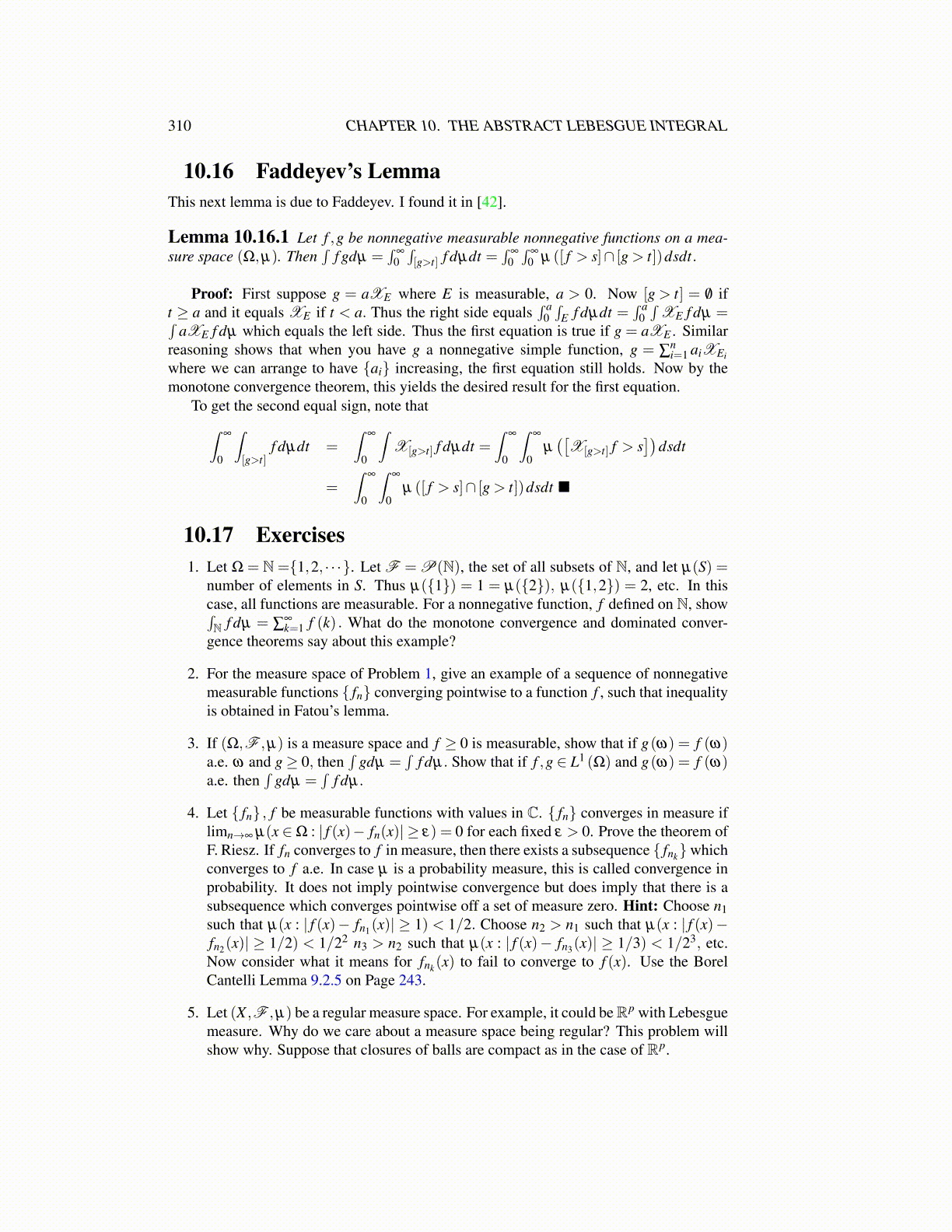
310 CHAPTER 10. THE ABSTRACT LEBESGUE INTEGRAL
10.16 Faddeyev’s LemmaThis next lemma is due to Faddeyev. I found it in [42].
Lemma 10.16.1 Let f ,g be nonnegative measurable nonnegative functions on a mea-sure space (Ω,µ). Then
∫f gdµ =
∫∞
0∫[g>t] f dµdt =
∫∞
0∫
∞
0 µ ([ f > s]∩ [g > t])dsdt.
Proof: First suppose g = aXE where E is measurable, a > 0. Now [g > t] = /0 ift ≥ a and it equals XE if t < a. Thus the right side equals
∫ a0∫
E f dµdt =∫ a
0∫
XE f dµ =∫aXE f dµ which equals the left side. Thus the first equation is true if g = aXE . Similar
reasoning shows that when you have g a nonnegative simple function, g = ∑ni=1 aiXEi
where we can arrange to have {ai} increasing, the first equation still holds. Now by themonotone convergence theorem, this yields the desired result for the first equation.
To get the second equal sign, note that∫∞
0
∫[g>t]
f dµdt =∫
∞
0
∫X[g>t] f dµdt =
∫∞
0
∫∞
0µ([
X[g>t] f > s])
dsdt
=∫
∞
0
∫∞
0µ ([ f > s]∩ [g > t])dsdt ■
10.17 Exercises1. Let Ω = N={1,2, · · ·}. Let F = P(N), the set of all subsets of N, and let µ(S) =
number of elements in S. Thus µ({1}) = 1 = µ({2}), µ({1,2}) = 2, etc. In thiscase, all functions are measurable. For a nonnegative function, f defined on N, show∫N f dµ = ∑
∞k=1 f (k) . What do the monotone convergence and dominated conver-
gence theorems say about this example?
2. For the measure space of Problem 1, give an example of a sequence of nonnegativemeasurable functions { fn} converging pointwise to a function f , such that inequalityis obtained in Fatou’s lemma.
3. If (Ω,F ,µ) is a measure space and f ≥ 0 is measurable, show that if g(ω) = f (ω)a.e. ω and g≥ 0, then
∫gdµ =
∫f dµ. Show that if f ,g ∈ L1 (Ω) and g(ω) = f (ω)
a.e. then∫
gdµ =∫
f dµ .
4. Let { fn} , f be measurable functions with values in C. { fn} converges in measure iflimn→∞ µ(x ∈Ω : | f (x)− fn(x)| ≥ ε) = 0 for each fixed ε > 0. Prove the theorem ofF. Riesz. If fn converges to f in measure, then there exists a subsequence { fnk}whichconverges to f a.e. In case µ is a probability measure, this is called convergence inprobability. It does not imply pointwise convergence but does imply that there is asubsequence which converges pointwise off a set of measure zero. Hint: Choose n1such that µ(x : | f (x)− fn1(x)| ≥ 1) < 1/2. Choose n2 > n1 such that µ(x : | f (x)−fn2(x)| ≥ 1/2) < 1/22 n3 > n2 such that µ(x : | f (x)− fn3(x)| ≥ 1/3) < 1/23, etc.Now consider what it means for fnk(x) to fail to converge to f (x). Use the BorelCantelli Lemma 9.2.5 on Page 243.
5. Let (X ,F ,µ) be a regular measure space. For example, it could beRp with Lebesguemeasure. Why do we care about a measure space being regular? This problem willshow why. Suppose that closures of balls are compact as in the case of Rp.